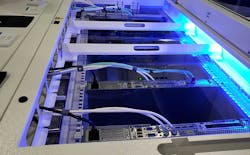Submer, ZutaCore Debut Liquid Cooling Tech at Open Compute Summit
Several emerging providers of liquid cooling technology for data centers are rolling out new designs at the Open Compute Project Summit 2019, which begins today in San Jose, Calif.
Submer Immersion Cooling, which submerges servers in dielectric fluid, is showcasing a new version of its SmartPod cooling enclosure that can house traditional 19-inch servers as well as the 21-inch Open Compute rack standard. ZutaCore will introduce a new version of its liquid-to-the-chip cooling system, which delivers a dieletric liquid coolant directly to the processor.
Both companies see an opportunity in the Open Compute Project, an open hardware initiative which is working to enable wider adoption of liquid cooling, citing demand from hyperscale computing providers, as well as new applications in edge computing. Over the past six years, the OCP community has leveraged open source designs from Facebook and other computing pioneers to win business in the hyperscale computing market.
Last year the OCP created an Advanced Cooling Solutions project, saying it is “responding to an industry need to collaborate on liquid cooling and other advanced cooling approaches.” Interest in advanced cooling is clearly on the rise in the wake of Google’s adoption of liquid cooling for its artificial intelligence hardware.
Submer Immersion Cooling
Daniel Pope’s focus on cooling began as a 16-year-old seeking to manage heat loads from a makeshift web hosting information in his bedroom. Now he’s the CEO of Submer Immersion Cooling, a startup with operations in Barcelona and San Jose.
The company’s immersion cooling tech can manage extreme power density and also offers potential economic benefits by allowing data centers to operate servers without a raised floor, computer room air conditioning (CRAC) units or chillers.
Server immersion has typically been the domain of high-performance computing (HPC) and bitcoin mining operations, but the growth of AI workloads powered by GPUs and other specialized chips has pushed rack densities higher in data centers operated by hyperscalers.
That’s why Submer is at the OCP Summit with its SmartPodX enclosure, which is the fourth iteration of the design. The company says its design can cool compute densities exceeding 100 kW per rack footprint.
A Submer SmartPodX enclosure, demonstrating how servers are housed and installed. (Image: Submer Immersion Cooling)
“We wanted to help the hyperscalers adopt immersion cooling with their roadmap,” said Pope. “The Open Compute Project exists to develop open standards that bring greater efficiency, scalability, openness, and positive impact to data centers and hardware. We’ve designed our product to be compatible with their hardware.”
Servers are inserted vertically into dielectric fluid in Submer’s enclosures. The SmartPodX platform can accommodate either standard 19-inch mountain rails or the 21-inch rails used by the OCP, which prefers the wider form factor to create more room for improved thermal management, as well as better connections for power and cabling. It can even combine the two form factors for companies with heterogenous environments.
“If a combination of gear is desired in the same SmartPod, we would install 21-inch rails and use adapters to secure the 19 equipment,” said Jeff Brown, Submer’s Managing Director for North America. “The primary distinction between the standard SmartPod 19-inch form factor and the OCP compliant SmartPod is how the power is distributed to the gear. We use a typical PDU in the standard model and a busbar in the OCP model.”
Submer says it has deployed “several megawatts” of SmartPod immersion cooling capacity since launching last year, supporting workloads for HPC, telecom, energy, colocation and blockchain customers. One of its most high-profile deployments has been at CERN, the particle physics lab that is home to the Large Hadron Collider.
There are a number of existing vendors offering single-phase immersion tanks with dielectric fluid, including Asperitas (which is also at the OCP Summit) and GRC (Green Revolution). Submer says its innovation is focused on its cooling distribution unit (CDU) and the fluid itself, which is proprietary to Submer.
“We didn’t set out to develop our own coolant, but our evaluation of fluids available in the market didn’t meet our operating and commercial requirements,” said Brown. “Specifically, we were unable to find and certify a suitable dielectric coolant that exhibited proper color, odor, viscosity, anti-corrosion, safety, environmental and longevity characteristics for a reasonable cost. Ultimately, we chose to engineer our own coolant in order to control these qualities.”
Submer says its SmartPod platform can deliver extreme efficiency, with a PUE (Power Usage Effectiveness, a key data center energy efficiency metric) of 1.03, as measured by a lab in Barcelona. That type of efficiency will likely be of interest to hyperscalers, many of whom have tested immersion cooling technologies in in-house labs or pilot deployments.
“While each project has its own success metrics, in the end, they are all trying to create more efficient computing environments by further compressing server density, eliminating overhead and deploying faster,” said Brown. “The feedback we are getting from these users strongly favors immersion cooling as the next big efficiency breakthrough for compute services. And with this announcement, members of the OCP community finally have an OCP compliant immersion solution.”
ZutaCore
Another cooling startup, Israel’s ZutaCore, will be at the Open Compute Summit, demonstrating its HyperCool2 technology at the LinkedIn booth. ZutaCore bills its technology as the first liquid cooling solution that is compliant with the Open19 standard for data center and edge solutions.
ZutaCore uses Novec, a dielectric liquid coolant from 3M that has proven popular in immersion cooling. Instead of dunking servers in a bath, ZutaCore is delivering the dielectric fluid directly to the processor, using a piping system to bring the liquid inside the server chassis.
ZutaCore uses two-phase cooling, in which heat from the chip is dissipated by interacting with a fluid, which is vaporized by the heat. It’s a similar approach to that at Ebullient Cooling but uses a different design in how the cooling fluid interacts with the processor. Here’s a look at a server equipped with the ZutaCore tech:
A closer look at the ZutaCore Enhanced Nucleation Evaporative (ENE) liquid cooling module, which brings two-phase coolant to the server chip. (Image: ZutaCore)
While many vendors at the OCP Summit are focused on Open Compute designs, ZutaCore is also targeting hardware optimized for Open19, an alternative open source hardware initiative created by LinkedIn as a standard for edge computing. That’s a contrast with Open Compute, whose offerings have been focused on hyperscale data centers. LinkedIn is a member of both open hardware initiatives.
ZutaCore’s cooling system consists of a server-kit that includes the Enhanced Nucleation Evaporative (ENE) module, a closed loop system that brings coolant to the processor, where it boils to remove the heat. The system also features a Smart-Refrigerant-Distribution Unit (S-RDU) and Smart-Heat-Rejection Unit (S-HRU), and a software package to manage the system.
About the Author



